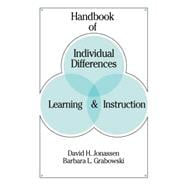
Note: Supplemental materials are not guaranteed with Rental or Used book purchases.
Purchase Benefits
Looking to rent a book? Rent Handbook of Individual Differences, Learning, and Instruction [ISBN: 9780805814132] for the semester, quarter, and short term or search our site for other textbooks by Jonassen, David H.; Grabowski, Barbara L.. Renting a textbook can save you up to 90% from the cost of buying.
| Dedication | p. vii |
| Acknowledgments | p. vii |
| Introduction | p. viii |
| References | p. xvii |
| Individual Difference in Learning and Instruction | p. 1 |
| Individuals, Differences, and Learning | p. 3 |
| Conclusion | p. 16 |
| References | p. 17 |
| Individual Differences and Instruction | p. 19 |
| Conclusion | p. 30 |
| References | p. 31 |
| Adapting Instruction to Individual Differences and Learning Outcomes | p. 35 |
| Introduction | p. 35 |
| References | p. 41 |
| Intelligence: Mapping Mental Abilities | p. 43 |
| Introduction | p. 43 |
| Conclusion | p. 50 |
| References | p. 51 |
| Second-Order Mental Abilities | p. 53 |
| References | p. 60 |
| Thurston's Primary Mental Abilities | p. 63 |
| References | p. 71 |
| Guilford's Structure of the Intellect | p. 73 |
| References | p. 81 |
| Introduction | p. 83 |
| Cognitive Controls | p. 83 |
| References | p. 85 |
| Field Dependence and Field Independence (Global vs. Articulated Style) | p. 87 |
| References | p. 98 |
| Cognitive Flexibility (Constricted vs. Flexible Control) | p. 105 |
| References | p. 110 |
| Bibliography | p. 111 |
| Impulsivity/Reflectivity (Cognitive Tempo) | p. 113 |
| References | p. 121 |
| Focal Attention (Scanning vs. Focusing) | p. 127 |
| References | p. 134 |
| Category Width (Breadth of Categorizing) | p. 137 |
| References | p. 145 |
| Cognitive Complexity/Simplicity | p. 149 |
| References | p. 160 |
| Automatization (Strong vs. Weak Automatization) | p. 165 |
| References | p. 170 |
| Cognitive Styles | p. 173 |
| References | p. 175 |
| Visual/Haptic | p. 177 |
| References | p. 186 |
| Bibliography | p. 188 |
| Visualizer/Verbalizer | p. 191 |
| References | p. 198 |
| Leveling/Sharpening | p. 201 |
| References | p. 207 |
| Serialist/Holist | p. 209 |
| References | p. 217 |
| Conceptual Style (Analytical/Relational) | p. 221 |
| References | p. 229 |
| Learning Styles | p. 233 |
| Hill's Cognitive Style Mapping | p. 235 |
| References | p. 245 |
| Kolb's Learning Styles | p. 249 |
| References | p. 260 |
| Dunn & Dunn Learning Styles | p. 263 |
| References | p. 274 |
| Grasha-Riechmann Learning Styles | p. 281 |
| References | p. 287 |
| Gregorc Learning Styles | p. 289 |
| References | p. 300 |
| Personality Types and Learning | p. 303 |
| References | p. 307 |
| Anxiety | p. 309 |
| References | p. 321 |
| Tolerance for Unrealistic Experiences | p. 325 |
| References | p. 331 |
| Ambiguity Tolerance | p. 333 |
| References | p. 340 |
| Frustration Tolerance | p. 343 |
| References | p. 349 |
| Locus of Control | p. 351 |
| References | p. 362 |
| Extroversion and Introversion | p. 367 |
| References | p. 377 |
| Achievement Motivation | p. 381 |
| References | p. 396 |
| Risk Taking Versus Cautiousness | p. 403 |
| References | p. 414 |
| Prior Knowledge | p. 417 |
| Prior Knowledge and Achievement | p. 419 |
| References | p. 427 |
| Structural Knowledge | p. 433 |
| References | p. 445 |
| Author Index | p. 449 |
| Subject Index | p. 467 |
| Table of Contents provided by Publisher. All Rights Reserved. |
The New copy of this book will include any supplemental materials advertised. Please check the title of the book to determine if it should include any access cards, study guides, lab manuals, CDs, etc.
The Used, Rental and eBook copies of this book are not guaranteed to include any supplemental materials. Typically, only the book itself is included. This is true even if the title states it includes any access cards, study guides, lab manuals, CDs, etc.